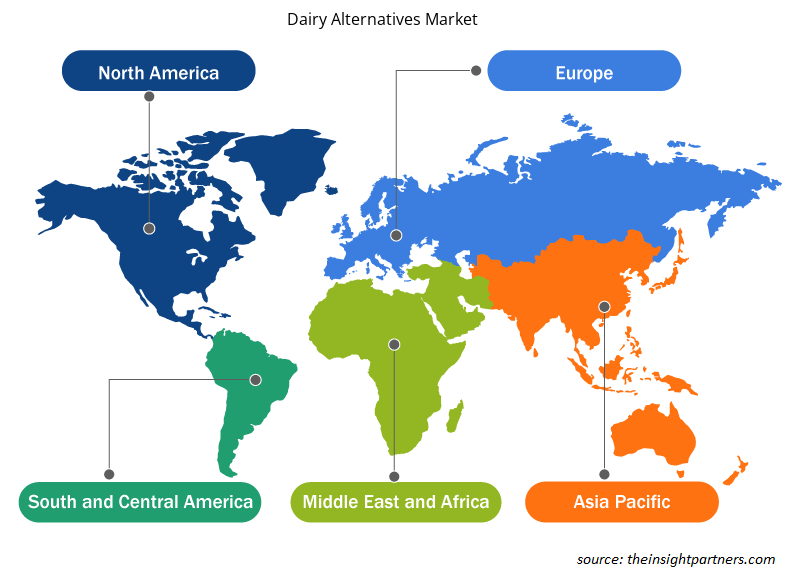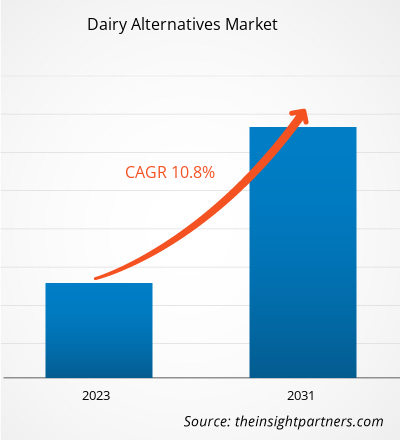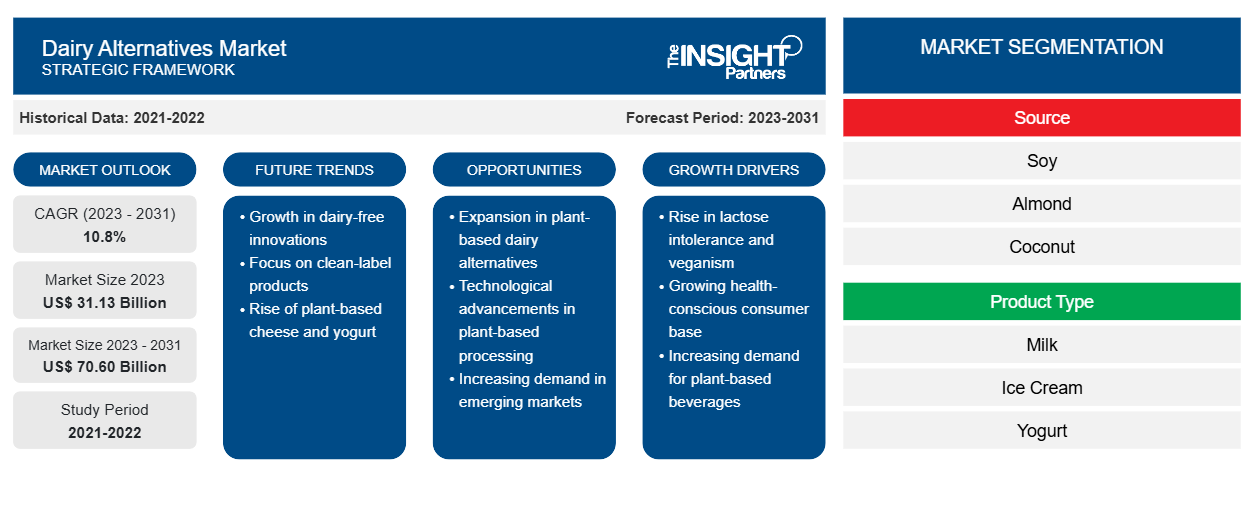Se proyecta que el tamaño del mercado de alternativas lácteas alcance los 70.600 millones de dólares en 2031, frente a los 31.130 millones de dólares en 2023. Se espera que el mercado registre una CAGR del 10,8 % durante el período 2023-2031. Es probable que la creciente demanda de alternativas lácteas funcionales siga siendo una tendencia clave en el mercado.CAGR of 10.8% during 2023–2031. Surging demand for functional dairy alternatives is likely to remain a key trend in the market.
Análisis del mercado de alternativas lácteas
La población vegana ha crecido significativamente en los últimos años. Según Veganuary (una organización sin fines de lucro que alienta a las personas de todo el mundo a hacerse veganas durante todo el mes de enero), más de 620.000 personas se inscribieron en la campaña Veganuary en 2022, y las inscripciones aumentaron un 200% en los últimos 3 años. La gente está cambiando cada vez más a una dieta vegana debido al aumento de las preocupaciones por la salud y la sostenibilidad. La industria ganadera es uno de los principales contribuyentes a las emisiones totales de gases de efecto invernadero de origen antropogénico. Según la Organización de las Naciones Unidas para la Alimentación y la Agricultura (FAO), la industria ganadera mundial emite 7,1 gigatoneladas de dióxido de carbono al año, lo que representa el 14,5% de todas las emisiones de gases de efecto invernadero de origen humano. El sector lácteo es responsable del 30% de las emisiones totales de la ganadería.
Muchos estudios han demostrado que adoptar una dieta vegana puede reducir significativamente las emisiones de dióxido de carbono. Según el Dr. Fredrik Hedenus, profesor de la Universidad Tecnológica de Chalmers (Suecia) y coautor de un artículo de investigación sobre el consumo de carne y productos lácteos publicado en la revista Climate Change, reducir el consumo de carne y productos lácteos puede ser crucial para reducir la contaminación climática agrícola a niveles aceptables.
Además, muchas organizaciones, como las Naciones Unidas, PETA y Good Food Institute, creen que el veganismo puede ayudar a salvar al planeta de la crisis climática. La conciencia sobre los efectos nocivos de la industria ganadera en el medio ambiente está aumentando entre los consumidores. El consumo de productos lácteos de origen vegetal ayuda a minimizar la huella de carbono, ahorrar agua y otros recursos naturales y reducir los impactos ambientales generales. Por lo tanto, los consumidores están cambiando rápidamente a productos lácteos y cárnicos de origen vegetal. Este factor está impulsando significativamente el mercado de alternativas lácteas.
Panorama general del mercado de alternativas lácteas
Las alternativas lácteas, como la leche, el yogur, el helado, el queso y la mantequilla, se elaboran a partir de leche de soja, leche de guisantes y leche de coco. La leche de soja es más asequible que otras leches vegetales y aporta una cantidad de proteínas similar a la de la leche entera. Los consumidores se inclinan mucho por los productos de origen vegetal o aptos para veganos debido a las crecientes preocupaciones por la salud y la creciente concienciación sobre el bienestar animal. Los productos de origen vegetal suelen considerarse alternativas más saludables. Además, la producción lechera está afectando negativamente al medio ambiente en general, lo que provoca el cambio climático. Este factor también está influyendo en el crecimiento del mercado de alternativas lácteas.soymilk, pea milk, , and coconut milk. Soymilk is more affordable than other plant milk, and it provides a similar amount of protein as whole milk. Consumers are highly inclined toward plant-based or vegan-friendly products due to increasing health concerns and growing awareness of animal welfare. Plant-based products are generally perceived to be healthier alternatives. Moreover, dairy farming is negatively impacting the overall environment leading to climate change. This factor is also influencing the growth of the dairy alternatives market.
Personalice este informe según sus necesidades
Obtendrá personalización en cualquier informe, sin cargo, incluidas partes de este informe o análisis a nivel de país, paquete de datos de Excel, así como también grandes ofertas y descuentos para empresas emergentes y universidades.
-
Obtenga las principales tendencias clave del mercado de este informe.Esta muestra GRATUITA incluirá análisis de datos, desde tendencias del mercado hasta estimaciones y pronósticos.
Factores impulsores y oportunidades del mercado de alternativas lácteas
El aumento de la incidencia de la intolerancia a la lactosa favorece al mercado
Según el Instituto Nacional de Diabetes y Enfermedades Digestivas y Renales (NIDDK), un promedio del 68% de la población mundial tiene intolerancia a la lactosa . Según el Instituto Nacional de Salud (NIH), la intolerancia a la lactosa es bastante común en la población adulta del este de Asia, afectando al 75-95% de las personas en estas comunidades. Además, la deficiencia congénita de lactosa se observa ampliamente en Asia Pacífico y África. Por lo tanto, países como China, Japón, Corea del Sur y Taiwán son mercados potenciales para las alternativas lácteas.NIDDK), an average of 68% of the world’s population has
Los productos lácteos de origen vegetal tienen una textura, cremosidad y consistencia similares a los productos lácteos convencionales. Están fortificados con nutrientes, como proteínas y calcio, para satisfacer las necesidades nutricionales diarias de los consumidores. Por ello, la creciente prevalencia de la intolerancia a la lactosa y las alergias a la leche entre los consumidores está impulsando el mercado de las alternativas lácteas.
El creciente número de lanzamientos de nuevos productos ofrece enormes oportunidades de crecimiento
Los fabricantes de alternativas lácteas están realizando importantes inversiones en innovación de productos para atraer a un gran grupo de consumidores. La estrategia de innovación de productos ofrece una ventaja competitiva a los actores que operan en el mercado, impulsando su rentabilidad. Los fabricantes de alternativas lácteas ofrecen productos orgánicos certificados, sin OGM, sin gluten, con etiqueta limpia y sin alérgenos para satisfacer las nuevas necesidades de los clientes. Además, como los consumidores se han vuelto conscientes de la salud , prefieren productos bajos en calorías y grasas. Por lo tanto, los fabricantes de productos lácteos de origen vegetal ofrecen productos sin azúcar y con bajo contenido de azúcar. Por ejemplo, en febrero de 2021, Hasla Foods lanzó un yogur de leche de avena sin azúcar en un tamaño familiar de 24 oz. El producto contiene solo 90 calorías por porción y no tiene azúcar agregado. En junio de 2021, la misma empresa amplió su presencia minorista al poner sus productos a disposición en 160 tiendas National Grocers by Vitamin Cottage en los EE. UU.
Además, los fabricantes están experimentando con diferentes fuentes de leche vegetal, como cebada, guisantes, cáñamo, semillas de chía, plátanos y anacardos. Por ejemplo, Take Two Foods, uno de los principales fabricantes de leche vegetal, ofrece leche de cebada enriquecida con nutrientes, que tiene una cartera completa de nutrientes, como proteínas, fibra, calcio y grasas insaturadas. Se espera que estas estrategias brinden oportunidades lucrativas al mercado de alternativas lácteas durante el período de pronóstico.
Análisis de segmentación del informe de mercado de alternativas lácteas
Los segmentos clave que contribuyeron a la derivación del análisis del mercado de alternativas lácteas son la fuente, el tipo de producto y el canal de distribución.
- Según las fuentes, el mercado de alternativas lácteas se divide en soja, almendras, coco, avena y otros. El segmento de la soja tuvo la mayor participación de mercado en 2023. Se proyecta que la soja gane popularidad entre los consumidores mayores y femeninos en los EE. UU., ya que incluye isoflavonas, que se dice que reducen el riesgo de enfermedades cardíacas y cáncer de mama. La soja también contiene fitoestrógeno, una hormona que funciona de manera similar al estrógeno en las mujeres. El consumo de alternativas lácteas a base de soja es popular entre las mujeres como terapia alternativa para aumentar los niveles de estrógeno. La soja es rica en nutrientes y tiene un alto contenido de proteínas en comparación con otras alternativas lácteas; por lo tanto, la popularidad de la soja por sus beneficios culmina en impulsar el mercado del segmento durante el período de pronóstico.
En términos de canal de distribución, el mercado está segmentado en supermercados e hipermercados, tiendas de conveniencia, venta minorista en línea y otros. El segmento de supermercados e hipermercados dominó el mercado en 2023. Los supermercados e hipermercados son grandes establecimientos minoristas que ofrecen una amplia gama de comestibles, alimentos, bebidas y otros artículos para el hogar. Los productos de varias marcas están disponibles a precios razonables en estas tiendas, lo que permite a los compradores encontrar el producto adecuado rápidamente. Además, estas tiendas ofrecen atractivos descuentos, múltiples opciones de pago y una agradable experiencia al cliente. Los supermercados e hipermercados se centran en maximizar las ventas de productos para aumentar sus márgenes de beneficio. Los fabricantes de productos lácteos de origen vegetal suelen preferir vender sus productos a través de supermercados e hipermercados debido a la gran afluencia de público que reciben estas tiendas. La creciente urbanización, el aumento de la población de clase trabajadora y los precios competitivos impulsan la popularidad de los supermercados e hipermercados en las regiones desarrolladas y en desarrollo.
Análisis de la cuota de mercado de las alternativas lácteas por geografía
El alcance geográfico del informe del mercado de alternativas lácteas se divide principalmente en cinco regiones: América del Norte, Asia Pacífico, Europa, Medio Oriente y África, y América del Sur/América del Sur y Central.
El mercado de alternativas lácteas de Asia Pacífico tuvo la mayor participación de mercado en 2023. En los últimos años, el consumo de alternativas a la leche ha aumentado de manera constante debido al creciente número de personas intolerantes a la lactosa y a las preocupaciones de salud sobre los antibióticos y las hormonas de crecimiento que a menudo se encuentran en la leche de vaca. La investigación realizada por Rakuten en 2021 mostró que el 87% de los consumidores en China había probado la leche de origen vegetal, el 50% había probado otros sustitutos lácteos, el 42% había probado la carne de origen vegetal y el 32% había probado los sustitutos veganos de los huevos. Además, la misma investigación encontró que el 3% de los encuestados solo consume alimentos de origen vegetal. Por lo tanto, el mercado de alternativas lácteas está creciendo debido a la creciente demanda de productos lácteos de origen vegetal debido a la creciente prevalencia de la intolerancia a la lactosa en Asia Pacífico.
Perspectivas regionales del mercado de alternativas lácteas
Los analistas de Insight Partners explicaron en detalle las tendencias y los factores regionales que influyen en el mercado de alternativas lácteas durante el período de pronóstico. Esta sección también analiza los segmentos y la geografía del mercado de alternativas lácteas en América del Norte, Europa, Asia Pacífico, Oriente Medio y África, y América del Sur y Central.

- Obtenga datos regionales específicos para el mercado de alternativas lácteas
Alcance del informe sobre el mercado de alternativas lácteas
| Atributo del informe | Detalles |
|---|---|
| Tamaño del mercado en 2023 | US$ 31,13 mil millones |
| Tamaño del mercado en 2031 | US$ 70.60 mil millones |
| CAGR global (2023 - 2031) | 10,8% |
| Datos históricos | 2021-2022 |
| Período de pronóstico | 2023-2031 |
| Segmentos cubiertos |
Por fuente
|
| Regiones y países cubiertos |
América del norte
|
| Líderes del mercado y perfiles de empresas clave |
|
Densidad de actores del mercado de alternativas lácteas: comprensión de su impacto en la dinámica empresarial
El mercado de alternativas lácteas está creciendo rápidamente, impulsado por la creciente demanda de los usuarios finales debido a factores como la evolución de las preferencias de los consumidores, los avances tecnológicos y una mayor conciencia de los beneficios del producto. A medida que aumenta la demanda, las empresas amplían sus ofertas, innovan para satisfacer las necesidades de los consumidores y aprovechan las tendencias emergentes, lo que impulsa aún más el crecimiento del mercado.
La densidad de actores del mercado se refiere a la distribución de las empresas o firmas que operan dentro de un mercado o industria en particular. Indica cuántos competidores (actores del mercado) están presentes en un espacio de mercado determinado en relación con su tamaño o valor total de mercado.
Las principales empresas que operan en el mercado de alternativas lácteas son:
- SunOpta
- Cultivadores de diamantes azules
- Nestlé SA
- Danone SA
- Avena Inc.
- Granjas Califia, LLC
Descargo de responsabilidad : Las empresas enumeradas anteriormente no están clasificadas en ningún orden particular.

- Obtenga una descripción general de los principales actores clave del mercado de alternativas lácteas
Noticias y novedades sobre el mercado de productos alternativos a los lácteos
El mercado de las alternativas lácteas se evalúa mediante la recopilación de datos cualitativos y cuantitativos posteriores a la investigación primaria y secundaria, que incluye publicaciones corporativas importantes, datos de asociaciones y bases de datos. A continuación, se incluye una lista de los avances en el mercado de los trastornos del habla y del lenguaje:
- La marca de leche vegetal Milkadamia llega al mercado refrigerado y demuestra que “menos es más” con el debut de su línea de leche y mezclas orgánicas de macadamia artesanal que evita los rellenos y las gomas comunes en muchas bebidas no lácteas y responde a una creciente demanda de opciones más caseras. (Fuente: Dairy Alternatives – Milkadamia, comunicado de prensa/sitio web de la empresa/boletín informativo, 2024)
- Califia Farms lanzó Califia Farms Complete, una leche vegetal cremosa con nueve nutrientes esenciales, ocho gramos de proteína, los nueve aminoácidos esenciales y la mitad del azúcar de la leche de vaca, según informó la empresa. (Fuente: Dairy Alternatives Califia Farms LLC, comunicado de prensa/sitio web de la empresa/boletín informativo, 2024)
Informe sobre el mercado de alternativas lácteas: cobertura y resultados
El informe “Tamaño y pronóstico del mercado de alternativas lácteas (2023-2031)” proporciona un análisis detallado del mercado que cubre las siguientes áreas:
- Tamaño del mercado y pronóstico a nivel global, regional y nacional para todos los segmentos clave del mercado cubiertos bajo el alcance
- Dinámica del mercado, como impulsores, restricciones y oportunidades clave
- Principales tendencias futuras
- Análisis detallado de las cinco fuerzas de Porter y PEST y FODA
- Análisis del mercado global y regional que cubre las tendencias clave del mercado, los principales actores, las regulaciones y los desarrollos recientes del mercado.
- Análisis del panorama de la industria y de la competencia que abarca la concentración del mercado, el análisis de mapas de calor, los actores destacados y los desarrollos recientes
- Perfiles detallados de empresas
- Análisis histórico (2 años), año base, pronóstico (7 años) con CAGR
- Análisis PEST y FODA
- Tamaño del mercado, valor/volumen: global, regional y nacional
- Industria y panorama competitivo
- Conjunto de datos de Excel
Informes recientes
Testimonios
Razón para comprar
- Toma de decisiones informada
- Comprensión de la dinámica del mercado
- Análisis competitivo
- Información sobre clientes
- Pronósticos del mercado
- Mitigación de riesgos
- Planificación estratégica
- Justificación de la inversión
- Identificación de mercados emergentes
- Mejora de las estrategias de marketing
- Impulso de la eficiencia operativa
- Alineación con las tendencias regulatorias























 Obtenga una muestra gratuita para - Mercado de alternativas a los lácteos
Obtenga una muestra gratuita para - Mercado de alternativas a los lácteos